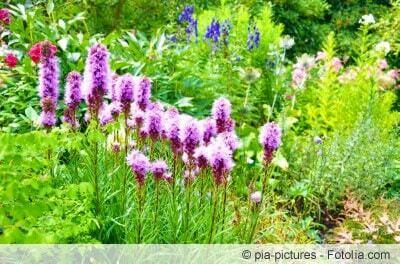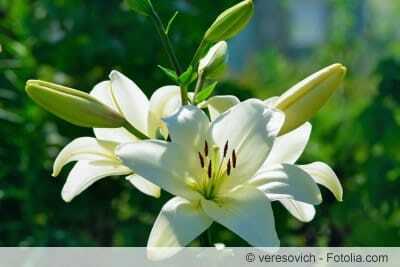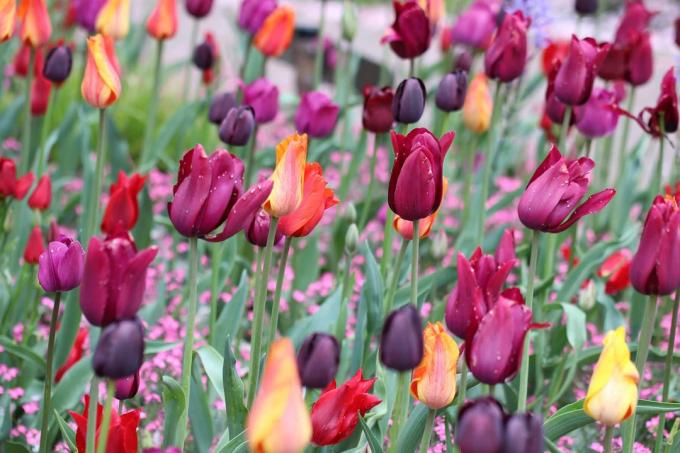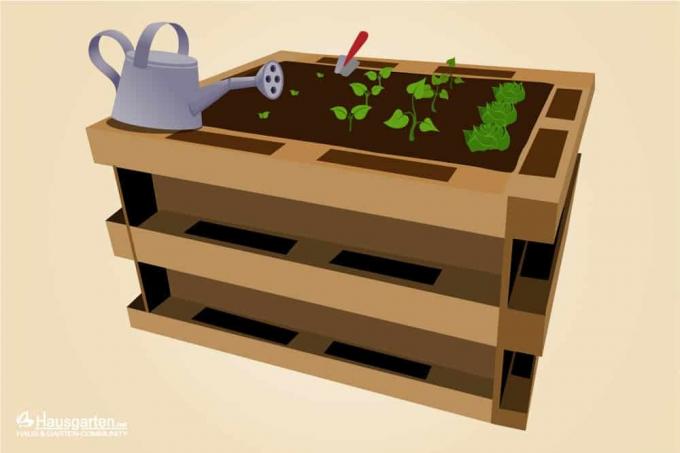

Table of contents
- Form and position
- Check lighting conditions
- Floor
- decision for the plants
- Blooms all year round
- themed beds
- planting distance
- planting examples
- border beds
- Conclusion
A flower bed only looks lush when several plants are in full bloom at the same time. It is best to place plants of the same species in different places in the bed. This repetition can avoid a disorderly hodgepodge in the bed. It is best to limit yourself to two or three colors or simply use different tones of one color. In addition, many flowers come into their own better when they are planted in smaller groups.
Form and position
First of all, a gardener has to think about which part of the garden he wants to plant a flower bed in. Once the place has been found, the form sometimes emerges all by itself. There are almost no limits to the size and shape.
- around
- square
- rectangular/diamond-shaped
- curved shapes
- other geometric shapes
- narrow beds and path borders
Tip:
The best thing to do is to draw up a plan of the garden with paths on paper (graph paper) and draw in your drafts "wildly" at first. You're sure to come up with really good ideas.
Check lighting conditions
When the right place has been found, it should be checked whether the location is in principle suitable for the desired planting. Especially when very specific plants are desired.
- full sun (including midday sun): ideal for a rock garden or steppe planting
- sunny to semi-shady (a few hours of shade daily): favorable conditions for almost all plants and flowers
- shady: a number of suitable plants can also be found here
Floor
Of course, what can be planted also depends on the soil conditions. In many well-maintained gardens, the gardener has already ensured in advance that the soil conditions are ideal for as many types of plants as possible. These include:
- good water permeability (improvement with sand)
- Balanced nutrient content (incorporate fertilizer or compost)
- medium humus content (compost or good potting soil)
- slightly acidic (pH values between 6.0 and 6.8)

In addition, it must be decided whether a bed edging should be created and a weed fleece should be laid in the ground.
Tip:
Before planting the flowers, the soil should be dug about 30 centimeters deep and possibly improved with sand or humus. In addition, all old plant parts such as roots or weeds must be removed. Now is the time to fertilize. An ideal basis is created with mature compost.
decision for the plants
First and foremost, plants for the flower bed must be selected based on site conditions. The soil conditions and the amount of direct sunlight falling on the bed are of crucial importance here. So that the plant combination in the bed works well, there are a few simple rules that every gardener who wants to create a flower bed should observe.
1. Lead plants/perennials
First of all, it should be determined which plant should have a dominant position. The so-called key plants are taller-growing perennials or small bushes that are particularly expressive and thus determine the appearance of the bed. The rest of the planting must be based on these key plants, of which only a few may be used. Too many (and too many different) leading plants only reduce the visual effect. Lead plants should always be placed in the back third of the bed (in the middle in round beds). Possible key plants can be:
- flame flowers
- Roses (upright species)
- lilies
- delphinium
- steppe candles
- Black cohosh
2. companion plants
Various accompanying plants are now selected to match the one or two key plant species. They are a little smaller than the main perennials and usually also less conspicuous. In principle, all flowering, medium-tall perennials and also medium-tall grasses are suitable here. The bed is particularly effective when the accompanying plants
- bloom in a similar shade to the main perennial
- represent a complementary color (orange to blue, purple to yellow, green to red)
About three to five different companion perennials are recommended for medium-sized flower beds. The best effect is achieved when the perennials are not arranged individually but as a smaller group of at least three plants (or more) around the main perennials. Examples of companion perennials:
- columbine
- asters
- lupins
- girl eye
- roses
- coneflower
- daylilies
3. filler plants
If the accompanying plants are positioned loosely around the main perennials, the remaining gaps are filled with filler plants. Ground covers are ideal for the front of the bed, while medium-tall ornamental perennials are the perfect choice for the middle and rear of the flower bed.
ground cover:
- cushion carnations
- cushion phlox
ornamental leaf perennials:
- Funkie (Hosta)
- ferns
- grasses
Blooms all year round

The most difficult work is to select plants for the individual perennial types that have different flowering times. Because this guarantees that there is always an eye-catcher in the flower bed from spring to autumn.
- early flowering plants
- late flowering plants
- Perennials that bloom almost all year round
- possibly evergreens or grasses for winter effect
themed beds
Flower beds that follow a certain basic principle have a special charisma. Such a theme also simplifies the selection for the individual perennials from the almost infinite variety of suitable plants.
- tone in tone
- Mixture of pink, white and blue
- White flowers on a dark green background
- Light Blue and Yellow
- Violet and dark yellow
- blue and orange
- Japanese beds, steppe beds, rock garden beds, heather garden beds
planting distance
Flower beds don't grow overnight. Even if the planting looks a bit sparse at first, the flowers should not be planted too densely. They usually take about three years to reach their size. Planted too densely, they hinder each other's growth because they compete for light and nutrients. The guideline is:
- half the height (mature plant) should be maintained as a planting distance
- for leading perennials (large plants): 60-80 cm
- with accompanying perennials (medium-sized): 40-50 cm
- Ground cover and other slow-growing plants: 15-20 cm
planting examples
It doesn't matter whether the soil is rather moist or dry and the location is sunny or more shady, there are a number of suitable plants for every location that thrive in these conditions.
Very sunny, dry locations with nutrient-poor soil
Ideal conditions for prairie or steppe gardens. Plants are used here that require little water and nutrients and also tolerate direct sunlight without any problems. These beds are very easy to care for, only a pruning is necessary after the winter.
- leading perennial: Banat globe thistle (Echinops bannaticus, 150 cm)
- companion perennial: Purple coneflower (Echinacea purpurea, 80 cm), blue rue (Perovskia abrotanoides, 50-80 cm)
- filler plant: Feather grass (Stipa tenuissima, 40-50 cm)

Sunny to partially shaded beds, humus-rich soil
Under these conditions, most plants grow optimally. The selection of perennials is almost unlimited.
Blue and white combination (bed size about 2 x 2 meters)
- leading perennials: 2 blue-violet flame flowers (Phlox paniculata), 1 white delphinium (Delphinium cultorum 'Pure white')
- companion perennials (rear area): 1 white coneflower (Echinacea), 1 frikart's aster (Aster x frikartii 'Monk'), 1 magnificent candle (Gaura lindheimeri), 2 white autumn anemones (Anemone japonica), 2 Feather Bristle Grasses (Sedum spectabile) Companion Perennials (front area): 2 White Stonecrops (Sedum spectabile), 2 White Gypsophila plants (Gypsophila paniculata) and 2 Lavenders (Lavandula angustifolia)
- filler plants (front area): right and left each 3 x cranesbill (Geranium magnificum), in the middle 3 white sage (Salvia nemorosa)
border beds
A really timeless and always beautiful planting idea for narrow, sunny borders are roses. They can be combined well with the following plants, because these plants bloom for a very long time just like roses and need similar site conditions:
- delphinium
- lavender
- sage

Partially shaded to shaded beds with moist soil (about 2 x 3 meters)
Plants that stand out with bright colors look particularly good in a shade garden.
- leading perennial: 1 monkshood (Aconitum) and 1 sheet (Astilboides tabularis) and 1 royal fern (Osmunda regalis)
- in the row before: 1 Penstemon (Penstemon digitalis), 1 Glossy Shield Fern (Polystichum aculeatum), and 1 Beard Grass (Schizachyrium scoparium)
- in the row before: 2 True Solomon's Seals (Polygonatum multiflorum), 2 Jacob's Ladder 'Purple Rain' (Polemonium yezoense)
- at the very front: 4 x snake beard (Ophiopogon planiscapus nigrescens), 3 light green Hosta (hosta), 2 woodruff (Galium odoratum)
Conclusion
Designing a flower bed is not that difficult. Once a suitable place has been found, it is best to first look for one or two large perennials that match each other in color. Next, clusters of half-tall companion perennials are planted around these leaders. They should have different flowering times and match the color of the main perennials. In the gaps (and the front area) finally put some ornamental foliage plants or ground cover. Important: Pay attention to site conditions and planting distance!
 garden editorial
garden editorial I write about everything that interests me in my garden.
Learn more about planting beds

Creating a flower bed: 9 tips for planning & designing
The transformation of a "naked" garden area into a lush sea of flowers doesn't just begin with the planting. Site conditions must first be checked and suitable plants selected. If you want to design a particularly beautiful bed, you can also add a pinch of creativity when laying it out.

The bed on the balcony - you have to pay attention to these things
Especially in spring, many people want to be active in their own garden. But not everyone is lucky enough to have the necessary property. Space is scarce and expensive, especially in urban areas. For this reason, the balcony is becoming a popular alternative for all hobby gardeners.

Building a raised bed: which stones are suitable?
A raised bed made of stones not only brings practical advantages because plants grow earlier and produce longer yields - it can also be an eye-catcher in the garden. Depending on the type of stone, however, there are significant differences.

11 Bed borders: what are the options?
There are many ways to border a garden bed. There are beautiful design borders, natural borders or those that are almost invisible. The following article briefly introduces the various bezel ideas.

Bed edging made of plants: Which ones are suitable as a bed border?
A bed border made of plants is above all temporary fads. With green vibrancy, numerous species and varieties give your ornamental and vegetable beds a picturesque setting. Let yourself be inspired by a colorful array of suitable plants with the potential for the perfect bed border.

Build a raised bed from wooden pallets - the 3 best building instructions
Growing vegetables, flowers and herbs at table height makes gardening a relaxing, active pleasure. A raised bed made of wood is easy on the back, keeps voracious snails at bay and serves as a rustic eye-catcher. With a little manual skill, you can easily build a raised bed from wooden pallets yourself. The 3 best building instructions show how it works.


